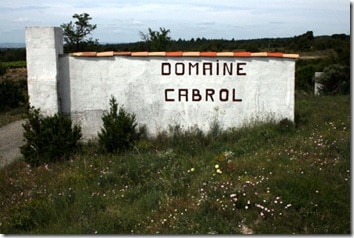2012 update – star Roussillon estates
Following a preliminary visit in spring 2011, a group from Andover Wine Friends had a week visiting wineries (and eating splendidly) in Roussillon in the first week of June 2012 to discover the star estates of Roussillon. While the British celebrated the Queen’s Jubilee in soggy conditions, we basked in southern sunshine, enlivened by one torrential thunderstorm perfectly timed to be during a long meal. The group visited many of the wineries already featured in this section of the website – Lesquerde, Robert, Gayda and Cazes – so this page will focus on the new estates:
- Coume del Mas, Collioure – making wine above the Med
- Treloar, Trouillas – handcrafted wines, cunning labels
- Mas Amiel, Maury – expanding from vin doux naturel
- Gardiès, Espira de l’Agly – quality, quality, quality
- Cabrol, Aragon – where East meets West
With good planning and no doubt a bit of luck too, these estates turned out to be outstandingly interesting visits. They showed the range of styles being made, continued the ‘ancient and modern’ theme commented on last year and, above all, are producing some really outstanding wines.
Coume del Mas, Collioure – making wine above the Med
Roussillon is a large and disparate region. Many of the best properties are to be found in the north of the area which has the Côtes du Roussillon Villages (CdRV) appellation (as opposed to straight Côtes du Roussillon, CdR). By contrast, the small area on the Mediterranean and abutting the Spanish border has two virtually coterminous appellations of its own – Banyuls for sweet, mostly red, wines and Collioure for dry wines.
At Coume del Mas Andy Cook explains some of the issues to be faced in this demanding zone. Bush vines may mean that nearly all work in the vineyard has to be done by hand but only this form of the vine will give the shade necessary in this sunny climate, resist the wind and can be grown on steep hillsides. When it comes to harvesting, the white grapes are picked at 4.30 in the morning to avoid the heat and immediately refrigerate them. The challenge is to pick at full ripeness and then avoid the precious juice turning to vinegar. During vinification, patience is the key, allowing wines as long as they need to ferment out, seeking to balance the inevitably quite high alcohol levels with fruit and acidity.
 We tasted a range of wines starting with the surprisingly good white – good enough to be imported by Berry Bros, Folio, AC Collioure Blanc, 2011. Made from 100% Grenache Gris, normally not the most exciting grape variety, this shows its potential here with pronounced lemon fruit, a tightly-knit palate and very good length. We follow this up with the tiny production Farniente Rosé 2011, 14%, a food wine with its slight phenolic grippiness, sweet fruit, modest bitter note and dry finish (only 2g/l residual sugar). Schistes Rouge 2010 is something of a standard-bearer for the winery as it is so typical of what it does best: simple vinification in stainless steel to reveal an intensely mineral and savoury fruity red made from 100% old-vine Grenache. To achieve this intensity, the must is kept on the skins for five weeks. We also tasted a bottle of 2006 which now shows pale garnet in the glass and is full of meaty, leather and jammy notes. While it was fascinating to taste the older wine, I preferred the younger one for its excellent fruit and vivacity. Also good was Quadratur Rouge 2008, which is a Grenache, Mourvèdre and Carignan blend which spends 14 months in oak. But its real secret is that this is made from the oldest, highest, lowest yielding vines (14 hl/ha … approaching disappearing point!) and is picked in October. The long ‘hang time’ results in full phenolic ripeness. A splendid combination of clove, tobacco and rich black fruit, dense and brilliant.
We tasted a range of wines starting with the surprisingly good white – good enough to be imported by Berry Bros, Folio, AC Collioure Blanc, 2011. Made from 100% Grenache Gris, normally not the most exciting grape variety, this shows its potential here with pronounced lemon fruit, a tightly-knit palate and very good length. We follow this up with the tiny production Farniente Rosé 2011, 14%, a food wine with its slight phenolic grippiness, sweet fruit, modest bitter note and dry finish (only 2g/l residual sugar). Schistes Rouge 2010 is something of a standard-bearer for the winery as it is so typical of what it does best: simple vinification in stainless steel to reveal an intensely mineral and savoury fruity red made from 100% old-vine Grenache. To achieve this intensity, the must is kept on the skins for five weeks. We also tasted a bottle of 2006 which now shows pale garnet in the glass and is full of meaty, leather and jammy notes. While it was fascinating to taste the older wine, I preferred the younger one for its excellent fruit and vivacity. Also good was Quadratur Rouge 2008, which is a Grenache, Mourvèdre and Carignan blend which spends 14 months in oak. But its real secret is that this is made from the oldest, highest, lowest yielding vines (14 hl/ha … approaching disappearing point!) and is picked in October. The long ‘hang time’ results in full phenolic ripeness. A splendid combination of clove, tobacco and rich black fruit, dense and brilliant.
We concluded the tasting with three sweet wines, vin doux naturel (VDN), one expression of this style typical of Roussillon. Banyuls Blanc 2011 is something of a rarity, being white. Made from Grenache Gris it is made in the same way as other VDNs, ie add nearly pure alcohol to a half fermented must, producing a wine in this case of 15.3% alcohol by volume but with sweetness derived from the ‘natural’ sugar from the original grapes – no botrytis, no semi-drying of the grapes. Here the fruit is very restrained with a pleasant herbal note showing through. We can say definitively that the oak is 40% new as two out of the five barriques were making their debut!
By contrast Galateo Banyuls 2010, 16.5%, is red and in a modern, fruit (Grenache) led style with long maceration and mutage sur grains, adding of high strength spirit while the must is still on the skins and pips, resulting in less oxidation. This results in a glass full of dense fresh plum and prune notes and moderate sweetness. Finally, there was Quintessence Banyuls 2009 which is a selection of the very best bunches from the oldest vines; it also spends a year in oak, as opposed to the six months for Galateo. Although this is a very young wine still, it shows great potential in its rich chocolatey and dense red fruit, concentration, fine tannins, balance; in short, outstanding in the modern style. Break for lunch in the port of Collioure?
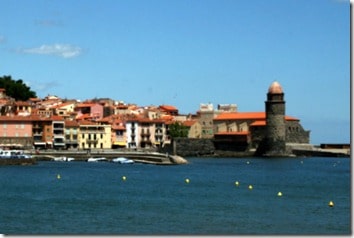
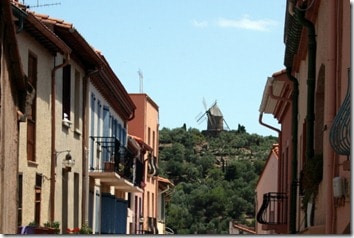
Domaine Treloar – handcrafted wines, cunning labels
In the afternoon we met another ex-pat winemaker, Jonathan Hesford of Domain Treloar wines, inland this time but still in the south of Roussillon. When I say ‘winemaker’ I mean that it is Jonathan, assisted by his wife Rachel, who takes every decision and carries out the vast majority of the work in the vineyard and in the winery. This is a small estate of 10 hectares which lends itself to a personal approach.
Standing in the middle of the vineyard Jonathan explains his approach. For him, it is less work to keep old vines. They may not be as productive in terms of yield but they let him focus on managing the soil, not the canopy because there is less rampant vegetative growth. He leaves the natural vegetation between rows as much as possible as it helps with water penetration (without it the water would just run off in mini-streams) and when it dies and rots down, it helps to feed the soil. The vision is for sustainable agriculture, not absolute positions. Thus he will use sulphur and synthetics together – but only when necessary. Later he proudly shows us his new intercept plough which will not only plough between rows but also between plants through a clever sensor device.

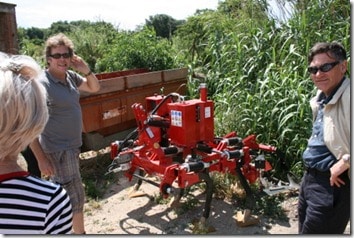
Mas Amiel, Maury – expanding from vin doux naturel
The next two wineries are situated in the more northerly, hillier, better-established area of Côtes du Roussillon Villages. Indeed, Mas Amiel, just outside Maury, is one of the historic wineries of the area, dating back to 1816. It has therefore been through the crises of phylloxera, the mixed fortunes of Roussillon in the twentieth century and the current refocusing on quality. Mas Amiel is synonymous with vin doux naturel made in the traditional oxidative way. Indeed when you arrive you are greeted by the amazing sight of the ‘field of bonbons’, the part filled glass carboys in which the vin doux naturel spend the first year of their ageing under the blistering sun of Roussillon. This rather brutal process accelerates the ageing of these wines which is then continued more conventionally in large cement or wood containers sometimes for decades.


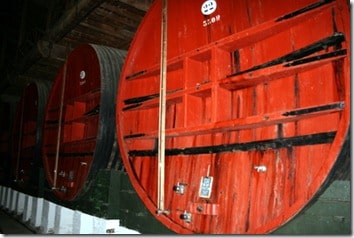
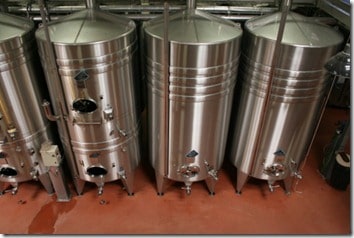
Old vines: Altaïr, CdRV 2009 is a complex three-way blend of Grenache Gris, Grenache Blanc and Macabeo which features the fruit of some 70 year old vines. The ageing is half in barriques of various ages and half in stainless steel. The end result is a wine of substance, and excellent depth of flavour, good minerality and balance, worthy of ageing. They are also promoting Vol de Nuit 2010 which is from Carignan planted in the first quarter of the last century which on a quick tasting was good but perhaps not in the same class as some other very old Carignan wines from the area. Carerades CdR 2008 which is a blend from variously ancient vines: Grenache from 1918, some Syrah (no record of age), and Carignan from 1880. This is very successful with its brilliantly forward fruit, a full palate, subtle and long.
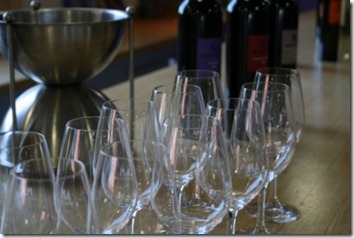

In the reds, three examples will show some of the range: Maury 2009 is the big production number, 100,000 bottles a year of 100% Grenache from young vines, the wine being aged for 12 months in stainless steel vats: simple, highly drinkable with prune, raisin and fresh plum fruit. Cuvée Prestige 15 ans has had the ‘leave it out in the sun’ treatment as a baby and then has been aged further in oak. We tasted the 10-year-old as well which had the caramel and coffee notes to which walnut is added by the extra years in the 15-year-old, along with a receding of the fruit. But on the finish, the fruit continues to be carried by the sugar. Finally, there was Millesime Maury 1975 which has spent a full 17 years in the cask to recover from the sunburn treatment, resulting in a wine of pronounced caramel and coffee notes, lifted aromas but with continuing freshness. Adding virtually pure alcohol to fruity Grenache musts at the halfway point of fermentation means that the fruit remains even in very old wines. Mas Amiel continues to be a beacon for the production of the sweet wines of Roussillon, while is new strength is in dry table wines.
Gardiès, Espira de l’Agly – quality, quality, quality
Sometimes you visit a winery and quality shines through everything that they do. We did not have the full vineyard and winery tour at Domaine Gardiès but you only have to taste the wine and you can tell that they are getting the important things right. It is not that difficult to produce full, fruit-led wines of power and substance in the warm Mediterranean climate of the Agly valley. But few wineries create balanced, powerful yet elegant, wines in the way this property does.
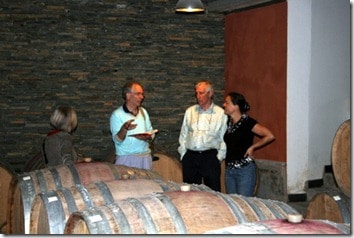

Les Glaciaires, Côtes de Roussillon Blanc, 2011 was the first of two whites, a blend of Roussanne, Grenache Blanc and Macabeo which has spent six months in barrels. It will undoubtedly develop in the bottle. The nose is currently rather neutral but the fruit on the palate is excellent and with good length. Its partner white is more assertive now, Mas Las Cabes, Vin de Pays des Côtes Catalanes, 2011, being made from Muscat (70%), Grenache and Macabeo. This is a fine approach to dry Muscat as it allows the freshness and floral character of the grape to express itself but complements it with a herby note and some palate weight which Muscat on its own would struggle to achieve.
 Le Rosé, Côtes de Roussillon, 2011 is an unusual rosé as it has spent six months maturing in barrels. As a result, it will have some staying power, not usually associated with pink wines. The colour comes from pressing the grapes – mainly Mourvèdre with some Grenache Noir and Cinsault. A very fragrant nose with restrained fruit (strawberry), what really stands out is the lush, silky palate. A fine wine for food and the company of those who will appreciate it.
Le Rosé, Côtes de Roussillon, 2011 is an unusual rosé as it has spent six months maturing in barrels. As a result, it will have some staying power, not usually associated with pink wines. The colour comes from pressing the grapes – mainly Mourvèdre with some Grenache Noir and Cinsault. A very fragrant nose with restrained fruit (strawberry), what really stands out is the lush, silky palate. A fine wine for food and the company of those who will appreciate it.
We then turned to three dry red wines, starting with Clos des Vignes, CdRV Tautavel 2009. Made from 70-year-old vines of Grenache and Carignan, this showed intense blackberry and some red fruit with excellent acidity but is still rather young to drink. La Torre CdRV 2009 comes from fruit grown on the black soils and is predominantly Mourvèdre (70%), filled out with Carignan and Grenache. Black fruit predominates here and again the fine acidity is a hallmark of the quality and poise of this wine. Finally, there is La Falaises CdRV Tautavel 2010, a blend of the very best Syrah, 90 year old Carignan and Grenache. This was remarkable for its fine, tightly knit fruit, but softer than the Mourvèdre-dominated La Torre with red fruit as well as black. Extremely youthful, this wine will really repay keeping for five to ten years.
 While the dry wines are what has brought the attention to Gardiès, this is Roussillon and so there are also Vin Doux Naturel. We tasted three different styles. Cerra (Catalan for cherry), AC Rivesaltes2009 is a young Grenache which has spent six months in the barrel and has less than 100g of residual sugar per litre. The nose was not particularly powerful but the palate was marked by intense cherry and strawberry fruit with a refreshing line of acidity. The mark here is sharp, lively fruit, not sweetness. Flor, Muscat de Rivesaltes 2011, a blend of the two common Muscat varieties, showed a fine muted Muscat nose, white flowers and orange, and an attractive rich palate, balance and impressive length. One of the best. These wines ageing potential was shown well by Rivesaltes Blanc Ambré 1998 (picture), with its pale amber colour, dense raisined fruit, cooked orange notes, and superb depth of flavour. The sweet wines at Gardiès are as impressive as the modern, dry, offering.
While the dry wines are what has brought the attention to Gardiès, this is Roussillon and so there are also Vin Doux Naturel. We tasted three different styles. Cerra (Catalan for cherry), AC Rivesaltes2009 is a young Grenache which has spent six months in the barrel and has less than 100g of residual sugar per litre. The nose was not particularly powerful but the palate was marked by intense cherry and strawberry fruit with a refreshing line of acidity. The mark here is sharp, lively fruit, not sweetness. Flor, Muscat de Rivesaltes 2011, a blend of the two common Muscat varieties, showed a fine muted Muscat nose, white flowers and orange, and an attractive rich palate, balance and impressive length. One of the best. These wines ageing potential was shown well by Rivesaltes Blanc Ambré 1998 (picture), with its pale amber colour, dense raisined fruit, cooked orange notes, and superb depth of flavour. The sweet wines at Gardiès are as impressive as the modern, dry, offering.
Domaine Cabrol, Aragon Cabardès – where East meets West
The final visit of the week was again into the southern part of the Languedoc, just north of the tourist magnet of Carcassonne, to the appellation known as Cabardès. This area is unusual in that both climatically and oenologically it owes something to the faraway Atlantic as well as to the much nearer Mediterranean. The appellation as a whole uses the tag of ‘East wind, West wind’ indicating its position in a gap of the Languedoc hills which marks the transition to the south-west of France. In terms of grape varieties, the AC unusually allows both Bordeaux varieties and the Mediterranean ones in the blends.
Within Cabardès, the leading domain is Claude Carayol’s Domaine Cabrol, situated 300m above sea level on white, stony soil. As you drive up from Carcassonne it is quite noticeable that the soil becomes visibly less fertile and thus more promising for high-quality wine. The climate is also critical: it is a combination of good levels of sunshine, low rainfall, wind, cool nights and it is typically two degrees cooler than Carcassonne. The total area of the estate is quite large at 125 hectares but the sole crop is wine from 21 hectares, the rest being semi-wild Mediterranean garrigue – and a few olive trees.
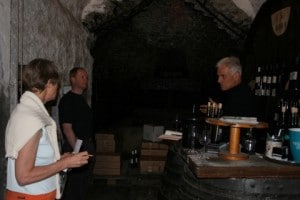 Réquieu AC Cabardès 2007 begins to show what this unusual appellation is about. The blend is from young vines made up of 33% Syrah, 33% Grenache and 33% Cabernet Franc … suddenly we have a wine which owes something to the Loire or Bordeaux, as well as to the Mediterranean. With the red fruit of the Syrah and Grenache there comes a green leafiness and, with bottle age, a hint of chocolate.
Réquieu AC Cabardès 2007 begins to show what this unusual appellation is about. The blend is from young vines made up of 33% Syrah, 33% Grenache and 33% Cabernet Franc … suddenly we have a wine which owes something to the Loire or Bordeaux, as well as to the Mediterranean. With the red fruit of the Syrah and Grenache there comes a green leafiness and, with bottle age, a hint of chocolate.
The next wine, Cuvée Vent d’Est, AC Cabardès 2007, owes rather more to Atlantic-influenced styles being made of 60% Cabernet Sauvignon, with 20% each of Grenache and Syrah. This showed intense blackcurrant fruit along with the classic Mediterranean herb finish and despite its five years of age, still grippy tannins. By accident, we tasted both the 2010 (too young) and the 2008 sibling Vent d’Est, AC Cabardès, in which the East/West proportions are reversed: 60% Syrah and 20% each of Grenache and Cabernet. The young wine had bright, attractive fruit on the nose, lower tannins than the preceding wine with more Cabernet but excellent acidity and complexity. With two further years in the bottle, the earlier vintage had developed what M. Carayol accurately called aromas which are ‘50% tapenade, 50% truffle’. Subtle, rounded out, developed complexity in the bottle.
By a different route, we also had the chance to taste two different vintages of the top wine starting with La Dérive, AC Cabardès 2007, an East-West blend of 40% Syrah, 10% Grenache, 40% Cabernet Sauvignon and 10% Cabernet Franc – the perfectly balanced expression of the AC Cabardès unusual cépage. The use of wood in ageing wines is very restrained at this estate: even this top wine is aged only in demi-muid, large, older barrels, for gentle oxidation but no new oak. Two years in the demi-muid is followed by two years in tanks before bottling. The effect of ageing in wood is noticeable because all the previous wines lead with fruit, but would otherwise be a very modest component. The effect of blending the varieties is that dense, beautiful fruit shines through but no obvious single varietal characteristics. Excellent length, outstanding. At a splendid lunch at La Bergerie, Aragon, we drank the 2004, which still leads with the quality fruit with the blackberry and blackcurrant now the main notes. The palate has softened with the fine, subtle tannins now creating a well-integrated, substantial and sophisticated wine. It provided a suitable climax to our visit to the distinctive Cabardès.
This second trip to Roussillon confirmed many of the good things about the region. But more than that it showed that there are really top quality wines being made by both the well-established players and the smaller, newer high-quality wineries profiled above.
Click here to return to Roussillon home page


